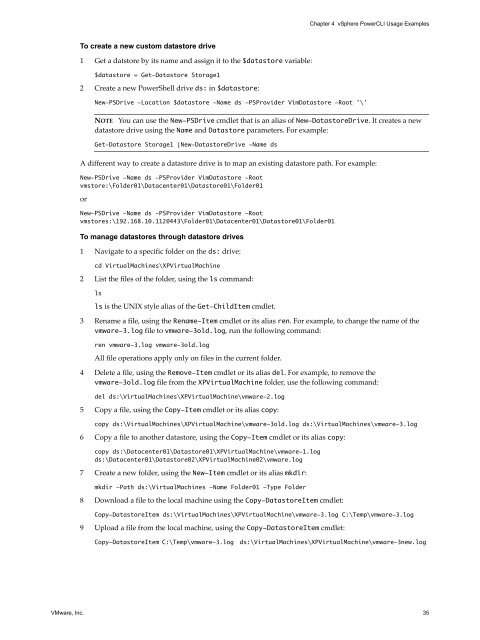vSphere PowerCLI User's Guide - Documentation - VMware
vSphere PowerCLI User's Guide - Documentation - VMware
vSphere PowerCLI User's Guide - Documentation - VMware
You also want an ePaper? Increase the reach of your titles
YUMPU automatically turns print PDFs into web optimized ePapers that Google loves.
To create a new custom datastore drive<br />
1 Get a datstore by its name and assign it to the $datastore variable:<br />
$datastore = Get-Datastore Storage1<br />
2 Create a new PowerShell drive ds: in $datastore:<br />
New-PSDrive -Location $datastore -Name ds -PSProvider VimDatastore -Root '\'<br />
Chapter 4 <strong>vSphere</strong> <strong>PowerCLI</strong> Usage Examples<br />
A different way to create a datastore drive is to map an existing datastore path. For example:<br />
New-PSDrive -Name ds -PSProvider VimDatastore -Root<br />
vmstore:\Folder01\Datacenter01\Datastore01\Folder01<br />
or<br />
NOTE You can use the New-PSDrive cmdlet that is an alias of New-DatastoreDrive. It creates a new<br />
datastore drive using the Name and Datastore parameters. For example:<br />
Get-Datastore Storage1 |New-DatastoreDrive -Name ds<br />
New-PSDrive -Name ds -PSProvider VimDatastore -Root<br />
vmstores:\192.168.10.112@443\Folder01\Datacenter01\Datastore01\Folder01<br />
To manage datastores through datastore drives<br />
1 Navigate to a specific folder on the ds: drive:<br />
cd VirtualMachines\XPVirtualMachine<br />
2 List the files of the folder, using the ls command:<br />
ls<br />
ls is the UNIX style alias of the Get-ChildItem cmdlet.<br />
3 Rename a file, using the Rename-Item cmdlet or its alias ren. For example, to change the name of the<br />
vmware-3.log file to vmware-3old.log, run the following command:<br />
ren vmware-3.log vmware-3old.log<br />
All file operations apply only on files in the current folder.<br />
4 Delete a file, using the Remove-Item cmdlet or its alias del. For example, to remove the<br />
vmware-3old.log file from the XPVirtualMachine folder, use the following command:<br />
del ds:\VirtualMachines\XPVirtualMachine\vmware-2.log<br />
5 Copy a file, using the Copy-Item cmdlet or its alias copy:<br />
copy ds:\VirtualMachines\XPVirtualMachine\vmware-3old.log ds:\VirtualMachines\vmware-3.log<br />
6 Copy a file to another datastore, using the Copy-Item cmdlet or its alias copy:<br />
copy ds:\Datacenter01\Datastore01\XPVirtualMachine\vmware-1.log<br />
ds:\Datacenter01\Datastore02\XPVirtualMachine02\vmware.log<br />
7 Create a new folder, using the New-Item cmdlet or its alias mkdir:<br />
mkdir -Path ds:\VirtualMachines -Name Folder01 -Type Folder<br />
8 Download a file to the local machine using the Copy-DatastoreItem cmdlet:<br />
Copy-DatastoreItem ds:\VirtualMachines\XPVirtualMachine\vmware-3.log C:\Temp\vmware-3.log<br />
9 Upload a file from the local machine, using the Copy-DatastoreItem cmdlet:<br />
Copy-DatastoreItem C:\Temp\vmware-3.log ds:\VirtualMachines\XPVirtualMachine\vmware-3new.log<br />
<strong>VMware</strong>, Inc. 35

















